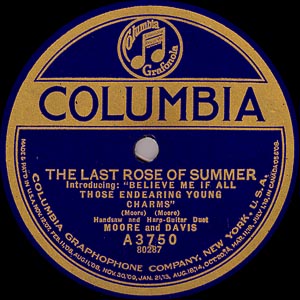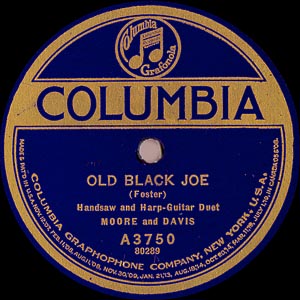

|
The Last Rose of
Summer (Columbia # A3750/80287) Old Black Joe (Columbia # A3750/80289) Moore & Davis (Handsaw and Harp-Guitar Duet) The following information comes from Mainspring Press. Note how the researcher describes Davis' harp guitar as "an odd hybrid instrument with six primary strings plus an additional set of strings that resonated sympathetically." On none of Davis' recordings (so far discovered) are any sub-bass strings heard. The Moores had already established
a reputation as musical family when Samuel Pasco Moore was born in
Monticello, Florida, on June 28, 1887. His father, Samuel Lewis Moore,
was a Civil War veteran and holder of a Confederate Cross of Honor.
Music, however, was only an avocation for the Moores, who owned a
construction business. Sam Moore on
Stage There followed many years as a headliner on the Keith and Orpheum vaudeville circuits. The Columbus (Georgia) Ledger for April 9, 1924, reported that "Among the most appreciative of Sam Moore's audiences are the negroes who go north... [they] often talk to the performer from the galleries, which makes the act 'go big'..." Moore's first vaudeville partner was Horace D. Davis, a great-grandson of Robert E. Lee and an accomplished guitarist who also performed under the name of John Powell. Around 1924 Moore teamed with Carl Freed, whose specialty was the musical spoons. They developed an act entitled "Spooning and Ballooning," with Moore playing an inflated rubber balloon to Freed's spoon accompaniment. An undated news clipping supplied by Betsy Loar noted that "'Spooning and Ballooning' is more or less of a riot at the Golden Gate this week... He [Moore] claims to be the inventor of rubber balloon music, and says it was suggested to him by his small son, who found a way of making weird noises with a similar balloon even after the whistle that came with it had been lost." By 1927, however, Moore seems to have been reunited with Davis. "Laughing Rag"
and the Octo-Chorda Moore's most successful recording of "Laughing Rag," musically as well as financially, was made for the Victor Talking Machine Company in their New York studio on August 24, 1921. For this session Moore again brought along Davis to accompany on the harp-guitar, an odd hybrid instrument with six primary strings plus an additional set of strings that resonated sympathetically. Victor inexplicably delayed release of the disc for six months, until February 1922, only to discover that they had a hit on their hands. The guitar interplay between Moore and Davis proved to be irresistible. Victor's version (18849) remains a perennial favorite with collectors and has been reissued several times, the latest instance being RCA's 1998 "Classic Ragtime" CD. In the program notes to that CD, historian Richard Spottswood praises Moore's "aggressive mainland verve...which stands halfway between Hawaiian and the 1920s country guitar rags of Sam McGee, Blind Blake, Roy Harvey, and Sylvester Weaver." "I've Seen Him
Get Music out of a Pitchfork" By the mid-1920s, with several firms marketing cheap musical saws and instruction courses, the hand saw was largely relegated to the status of an amateur's novelty instrument. Moore carried on, championing the hand saw as well as a host of other instruments that had fallen from (or, in the case of the rubber balloon, never attained) grace. A 1920s newspaper article reported that Moore's hand saw was "the same kind you see carpenters use every day.... The saw has to be pulled with great strength - measures show the pulling strength exerted to be 200 pounds - before the metal is in the exact condition, or tension, to give the marvelous results produced by Mr. Moore." Later Years http://www.mainspringpress.com/moore.html |
